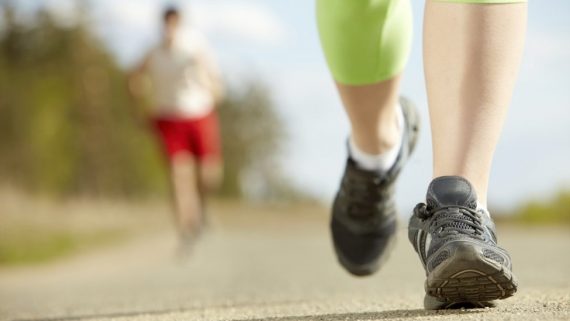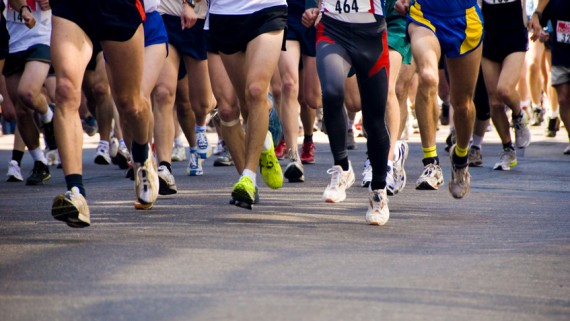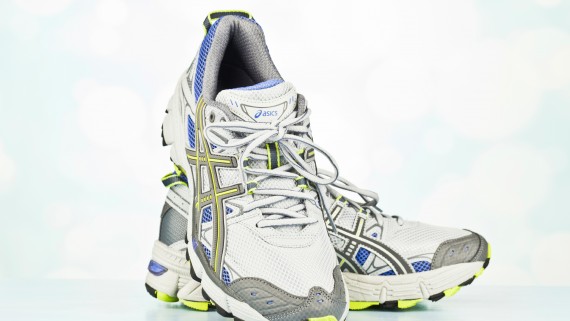Walking and Running
Did you know that daily walking and/or running are some of the most important steps in reducing your risk of heart disease, diabetes, osteoporosis and many other serious health conditions?
You may be wanting to improve your well-being, or reduce your risks of health conditions, or simply to start a new hobby, so here are some easy steps to begin your walking/running routine!
- Set realistic targets and goals. This could be a walking/running distance, weight loss (in combination with good diet), or seeing if you can improve your time running around the block.
- Ensure you have the most appropriate shoes possible by seeing a Podiatrist, who can also help you plan your walking/running sessions.
- Start off easy. This could mean a short walk around the block, or a light jog to the milkbar and back. Everyone is different, so do what works for you.
- Set a routine. Put a particular time aside each day for your exercise, and stick to it!
- If you’re feeling lonely, invite your partner, friend, colleague to exercise with you!
- Don’t feel bad if you have to skip a day, just stay positive and look forward to the next session!
- Make sure you’re having fun! Yes, you will get tired and sweaty, but if take notice of your surroundings, play some music and smile, you are on your way to making a beneficial routine!
For further advice on footwear, running, walking, click on the link below to make an appointment or call 1300 847 226.
http://www.thepodiatrygroup.com.au/booking/
Melbourne Marathon Podiatry Tips
At The Podiatry Group we are often asked for our top tips when training for a marathon. With the Melbourne Marathon coming up we have decided to give you a little insight to some helpful guidelines to consider when training and running in a marathon. The internet can provide a whole text book of information from how to carb load before an event to the best anti chafing stick to use. We will let you in on the best advice we provide for runner’s feet during their marathon.
- Get your runners professionally fitted. There are stores like Active Feet who are highly trained to fit running shoes. They can observe your running and walking patterns on a treadmill to better assess which shoe is most appropriate for you. Remember that runners will only last on average between 600-800kms so if you have been training hard make sure that by the time you reach your marathon day, your shoes still have life in them. If you are considering purchasing a new pair of shoes before your marathon, make sure that you have enough time to wear them in slowly before the big day. This means that you should have them at least 2 weeks before your event and begin wearing them in at home for a few hours and gradually progressing to a walk then a run. If you are purchasing the same brand and style as your last shoe make sure you speak with the person selling you your shoes to see if there have been any significant changes between the last and latest model. Sometimes the heel height (heel pitch) of a shoe will reduce or increase compared to the forefoot. This may alter the way that you run and impact the style of running you have trained for. At The Podiatry Group we are able to help assess your runners and ensure they are the right shoe for your running style and technique.
- Make sure you have the right socks. This may seem a silly statement; some of you may think that all socks are equal. We are here to tell you that they are not. There are socks that are designed to help prevent blistering. A small blister might not seem too daunting, but over a 42km run it can slowly but surely cause you more discomfort then you could imagine. There are socks that are specifically designed to wick moisture away from the feet leaving them dry. Some brands that are able to do this are Thorlo, Wigwam and Injinji.
- Make sure your nails are cut! Cut your nails before an event but leave 1mm of nail growth at the end (1mm of the white part of the nail), this will ensure you don’t cut the too short and bleed causing a bit of a mess and some sore toes before you even begin running. This will also help minimise the risk of your nails going black from bruising or even losing your nails after a marathon. Sometimes our nails get blackened or fall off after an event like a marathon from repetitive micro-trauma. This can be where our toes hit the end of our shoes when running causing micro damage to the nail. This can also be due to our shoes not being laced properly.
- Get rid of that build up of hard skin! If you have callous on your feet then odds are you have a lot of pressure and friction occurring at that site. If you would like this professionally removed then contact us. If you only have a small amount and think you can manage yourself then the best way is to use a pumice stone. A pumice stone must be used wet (in the bath or shower), it is best used if you rub the pumice stone on a cake of soap and then on the hardened skin until you have taken enough off.
- Compression stockings can help aid recovery time. It has been shown that an average persons calf will expand in diameter after standing for 1-3 hours. As such, you can imagine that when running a marathon (which could take anywhere between 3-5 hours depending on your speed) your calf will expand and could cause discomfort and a feeling of fatigue. We recommend that all runners consider compression stockings. Please note that we strongly advise that a runner come in for an assessment before using a high grade compression stocking.
- Have fun! You may choose to run a marathon only once in your life or you may be crazy enough to run many times. Our most important tip we could give you is to enjoy it. You’ve worked so hard to get to where you are, all those training sessions, all that blood sweat and tears, just don’t forget to enjoy yourself.
If you are training for a marathon and want to speak with one of our Podiatrists then you can contact us. We have Podiatry Clinics located in Cranbourne, Drouin and Warragul.
How to choose the right runner for you?
Choosing a new pair of runners can be overwhelming. Sometimes we look at our old and faithful runners and think maybe they’ll last me another 12 months, they don’t look too bad? Think again. Runners will only hold up on average for 600-800 kilometres. So if you run around 5 kilometres, three times a week and do no other training in your runners, then they should last you approximately 12 months. However, if you do this amount of running as well as using them every weekend then there life will be much shorter.
At the 12 month mark a shoe often looks in good condition from the outside, but it is the midsole that we cannot see that begins to break down and lose support. The shoe’s ability to absorb shock and provide cushioning begins to deteriorate as the shoe gets older and more worn.
Once we have come to terms with the fact that we need a new pair of runners where do we go? The bright lights and fancy colours on the shelves in the footwear stores may mesmerise us for a moment but it is important to keep our cool and that we don’t just choose a shoe based on it’s appealing colours.
Even your favourite shoe that you have worn for the last season may have changed. It may have changed weight; some will even try to drop by 20 grams, it may have changed material and therefore support. It is important that when choosing a runner you are aware of the support you require. Some runners are classed as neutral; providing cushioning and some are considered in the control category; providing differing levels of support. A runner with a higher arch and neutral running gait might be more suited to a neutral style of runner whereas a runner with a flatter foot and a pronated (rolled in) gait might be more suited to a control style of runner.
The first step before lunging head first in to the world of running shoe reviews on Google, is to have your gait (walking and running pattern) assessed by a podiatrist or by a footwear store with the capability and experience in assessing gait. This way you can be advised on a shoe that is best suited to your needs. This will include your running style, training surfaces, distance and goals. Then you can be confident that your money will be well spent- let’s be honest, the latest pair of high end runners cost a little more than a loaf of bread. You want to make sure you will like it before you buy it!
If you are serious about running then get your gait professionally assessed by The Podiatry Group and give yourself the best possible chance to enjoy your runs with the comfort and reliability of a good shoe.



